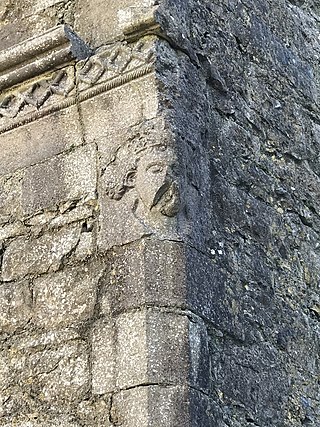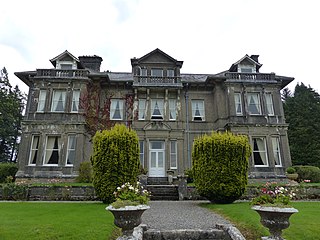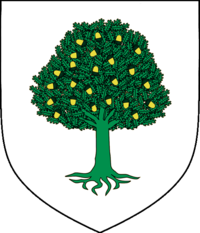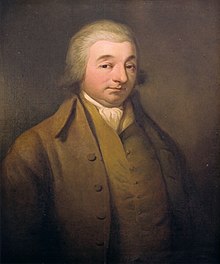
Ruaidrí mac Tairrdelbach Ua Conchobair was King of Connacht from 1156 to 1186, and High King of Ireland from 1166 to 1198. He was the last High King of Ireland before the Anglo-Norman invasion.

West Connacht was a kingdom of Gaelic Ireland, associated geographically with present-day County Galway, particularly the area known more commonly today as Connemara. The kingdom represented the core homeland of the Connachta's Uí Briúin Seóla kindred and although they ruled, there were smaller groups of other Gaels in the area, such as the Delbhna Tir Dha Locha and the Conmhaícne Mara. It existed from 1051 onwards, after the Ó Conchobhair, Kings of Connacht, pushed the Ó Flaithbheartaigh to the West of Lough Corrib, from their original territory of Maigh Seóla. Iar Connacht remained a subordinate túath of Connacht, until the 13th century, after which it was more independent.

O'Flaherty is an Irish Gaelic clan based most prominently in what is today County Galway. The clan name originated in the 10th century as a derivative of its founder Flaithbheartach mac Eimhin. They descend in the paternal line from the Connachta's Uí Briúin Seóla. They were originally kings of Maigh Seóla and Muintir Murchada and as members of the Uí Briúin were kinsmen of the Ó Conchubhair and Mac Diarmada amongst others. After their king Cathal mac Tigernán lost out to Áed in Gai Bernaig in the 11th century, the family were pushed further west to Iar Connacht, a territory associated with Connemara today. They continued to rule this land until the 16th century. The name has been alternatively rendered into English in various forms, such as Flaherty, Fluharty, Faherty, Laverty, Flaverty, Lahiff, and Flahive.
Conchobar Maenmaige Ua Conchobair, son of High King of Ireland Ruaidrí Ua Conchobair, was King of Connacht from 1183 to 1189. He was a military commander and opponent of the Norman invasion of Ireland.

Cathal Crobhdearg Ua Conchobair (1153–1224), was a king of Connacht. He was the youngest son of the High King of Ireland Tairrdelbach Ua Conchobair and brother to the last fully recognized High King Ruadri Ua Conchobair. His own sons Aedh Ua Conchobair and Feidhlimidh Ua Conchobair were kings of Connacht after him.
Aedh mac Cathal Crobdearg Ua Conchobair was King of Connacht with opposition alongside his uncle Toirdhealbhach mac Ruaidhrí Ó Conchobhair. Aedh succeeded his father Cathal Crobhdearg upon his death in 1224 but struggled to assert control over the entire province. His reign closely mirrored the early years of his fathers with two rival claimants, backed by outside powers, fighting an indecisive civil war lasting several years.
Aedh mac Ruaidrí Ua Conchobair was King of Connacht from 1228 to 1233. He was one of the sons of the last fully recognized High King of Ireland Ruaidrí Ua Conchobair, and claimed the kingship of Connacht after deposing his brother Toirdhealbhach Ó Conchobhair, after the death of their rival, cousin and former king Aedh Ua Conchobair. In 1233 he was killed in battle by the supporters of his cousin and successor Felim O'Connor. He was the last descendant of Ruaidrí to hold the kingship.
The Kings of Magh Luirg or Moylurg were a branch of the Síol Muireadaigh, and a kindred family to the Ua Conchobair Kings of Connacht. Their ancestor, Maelruanaidh Mor mac Tadg, was a brother to Conchobar mac Tadg, King of Connacht 967–973, ancestor of the O Connor family of Connacht. Maelruanaidh Mor mac Tadg is said to have made a deal of some nature where, in return for abandoning any claim to the provincial kingship, he would be given Moylurg. His dynasty was known as the Clan Mulrooney, and later still took the surname of MacDermot. The following is a list of their Kings, followed by the respective heads of the family up to the early modern period.
Felim McHugh O'Connor was king of Connacht in Ireland from January 1310 to 10 August 1316. The beginning of his kingship saw a revival in the ancient form of inauguration performed for the Kings of Connacht after a period of apparent lapse in the practice. His reign took place against the background of a Gaelic recovery following the Anglo-Norman invasion and the disputed High Kingship of Edwurd Bruce. He was the last King of Connacht to truly hold power over the entire province and his death halted the gains that had been made following the Anglo Norman invasion, by his kingdom. His foster father Maelruanid Mac Diarmata King of Magh Lurg would play an instrumental role in his reign.
The city of Galway Ireland was built as a naval base and military fort by Tairrdelbach mac Ruaidri Ua Conchobair in 1124, refounded as a military outpost and town by Richard Mor de Burgh in 1230 - has been subjected to a number of battles, sacks and sieges. This article enumerates the history of military conflict in Galway.
Ruaidri mac Tairdelbach Ua Conchobair, King of Connacht, died 1384. The previous king though not listed was slain and defeated by the Ó Cellaigh's of Ui Maine.
Denis Armar O'Conor, O'Conor Don was hereditary Chief of the Name O'Conor, and is a direct descendant of Tairrdelbach Ua Conchobair, the last High King of Ireland with a surviving male-line lineage and was seen by some as a nominal claimant to that defunct position.

Clonalis House is an historic manor house in Castlerea, County Roscommon, Ireland, and the ancestral home of the O'Conor Don, who is a direct descendant of Cathal Crobhdearg Ua Conchobair, King of Connacht, a younger brother of Ruaidrí Ua Conchobair, the last High King of Ireland.
The Clan Murtagh O'Conor were descendants of Irish High-King Toirdelbach Ua Conchobair, through his son, Murtogh Moynagh O'Conor (d.1210), tánaiste of Connacht. They have been defined by Katherine Simms as:
... the earliest, most aristocratic and best documented example of increasing nomadism in the northern half of Ireland in the late middle ages. ... In spite of the fact that they were a very numerous branch of the O'Conor family, who supplied five kings to the throne of Connacht, they seem to have vanished away in the early fifteenth century, never to be heard of again.
Fearghal Ó Taidg an Teaghlaigh, Chief of the Name, Marshal and bodyguard of King Cathal Crobhdearg Ua Conchobair of Connacht and his successor, Aedh, died 1226.
Áed Ua Conchobair or Áed in Gai Bernaig was the King of Connacht, and reigned from 1046 to 1067. He was the son of Tadg in Eich Gil.
Owen Ó hEidhin was King of Uí Fiachrach Aidhne.
Aedh Dall Ua Conchobair, Prince of Connacht, died 1194.
Murtogh Moynagh O'Conor, prince of Connacht, Ireland, flourished 1156-1210.
Mór Ní Briain was Queen of Connacht, and died 1218. She was a daughter of King Domnall Mór Ua Briain of Thomond. Domnall's wife was Órlaith Ní Murchadha, Princess of Leinster, daughter of Queen Mor Ui Thuathail and King Diarmaid Mac Murchadha of Leinster.












